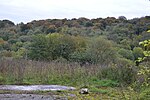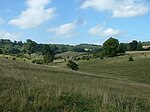Buckland Common
EngvarB from June 2016Hamlets in Buckinghamshire

Buckland Common is a hamlet in Buckinghamshire, England. It is located in the Chiltern Hills, 4 miles (6.4 km) east of Wendover and the same distance south of Tring in Hertfordshire with which it shares a boundary. The northern end of the settlement is delineated by a short section of Grim's Ditch. It is in the civil parish of Cholesbury-cum-St Leonards.
Excerpt from the Wikipedia article Buckland Common (License: CC BY-SA 3.0, Authors, Images).Buckland Common
Parrott's Lane,
Geographical coordinates (GPS) Address Nearby Places Show on map
Geographical coordinates (GPS)
| Latitude | Longitude |
|---|---|
| N 51.7553 ° | E -0.6666 ° |
Address
Parrott's Lane
Parrott's Lane
HP23 6NX , Cholesbury-cum-St Leonards (Chesham and Villages Community Board)
England, United Kingdom
Open on Google Maps










